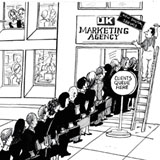Survey paints rosy picture as design shakes off slump

UK design has shaken off the slump of 2001 and is showing signs of renewed strength and stability, according to a key report out this week.
Willott Kingston Smith’s annual Financial Performance of Marketing Services Companies survey shows that average operating profits for design and branding consultancies rose by 10 per cent year on year during 2006, while pre-tax profits were up 26 per cent.
The additional costs involved in reorganising businesses and cutting staff – which have held back the financial health of the sector in recent years – have now, in the main, disappeared, and the industry is performing more strongly.
‘Design businesses have taken the pain of getting things back in the right ratio to each other following the 2001 slump,’ said Amanda Merron, partner at WKS. ‘Now, in what feels, overall, like a flat market, gross income is up 12 per cent.’
The survey measures the performance of the top 30 design and branding consultancies, ranked by gross income as shown in accounts filed at Companies House. The results are therefore skewed towards the best performers in the industry and relate to fewer than half of all consultancies in the sector, but its results show some emerging trends.
While some larger players continue to drag down the industry average (Fitch lost 430 per cent from its operating profits, while Interbrand slipped 14 per cent), independents are gaining ground. Half of all consultancies in the top 30 are independent operators, and the majority reported increased gross income and profits, a factor the report puts down to their flexibility and freedom to make decisions relevant to a single business, rather than a parent group.
For the first time, the survey includes digital specialists, which Merron describes as a huge growth area. ‘Many more clients are demanding some form of digital capability and they want it now,’ she said. But she questions the role that design will play in the digital future. ‘There are issues in the industry around seeing design strategically. Brand managers are lower down than marketing managers and design lacks an entry point within a client business.’
Design is by and large being overlooked in the mergers and acquisitions market. Larger marketing groups are on the look-out for businesses that have a focus on communications planning or seeks to boost their digital and search operations; design is not seen as core to such offerings, says Merron.
But with overall productivity outperforming that of the broader marketing services industry, and with signs that consultancies are beginning to recruit again, WKS paints an upbeat picture of the design industry looking ahead.
Despite this overall increase in productivity, however, many consultancies still fail to generate gross income of between £80 000 and £100 000 a head – a figure that a well-run design business should achieve, according to WKS. The average gross income per employee in 2006 was £82 349. Jack Morton Worldwide topped the productivity table, recording gross income per employee of over £168 000. But only seven consultancies topped the £100 000 mark – fewer than last year – which is something that Merron urges the industry to address.
Top 30 branding and design groups financial performance:
• Operating profits up 9.7%, pre-tax profits up 25.6% and operating margins static at 9%
• Productivity continues to improve and consultancies start to recruit
• Increase in the number of independent consultancies in the top 30
• Group-owned consultancies outperform independents in terms of productivity and profitability
• Balance sheets strengthen, as does net cash position
• Productivity is greater than for the top 50 marketing services companies, but operating margins are lower
-
Post a comment



